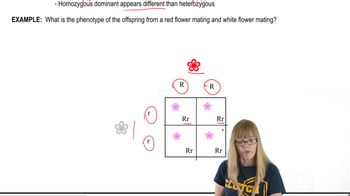Table of contents
- 1. Introduction to Genetics51m
- 2. Mendel's Laws of Inheritance3h 37m
- 3. Extensions to Mendelian Inheritance2h 41m
- 4. Genetic Mapping and Linkage2h 28m
- 5. Genetics of Bacteria and Viruses1h 21m
- 6. Chromosomal Variation1h 48m
- 7. DNA and Chromosome Structure56m
- 8. DNA Replication1h 10m
- 9. Mitosis and Meiosis1h 34m
- 10. Transcription1h 0m
- 11. Translation58m
- 12. Gene Regulation in Prokaryotes1h 19m
- 13. Gene Regulation in Eukaryotes44m
- 14. Genetic Control of Development44m
- 15. Genomes and Genomics1h 50m
- 16. Transposable Elements47m
- 17. Mutation, Repair, and Recombination1h 6m
- 18. Molecular Genetic Tools19m
- 19. Cancer Genetics29m
- 20. Quantitative Genetics1h 26m
- 21. Population Genetics50m
- 22. Evolutionary Genetics29m
2. Mendel's Laws of Inheritance
Probability and Genetics
Problem 18b
Textbook Question
In pea plants, the appearance of flowers along the main stem is a dominant phenotype called 'axial' and is controlled by an allele T. The recessive phenotype, produced by an allele t, has flowers only at the end of the stem and is called 'terminal.' Pod form displays a dominant phenotype, 'inflated,' controlled by an allele C, and a recessive 'constricted' form, produced by the c allele. A cross is made between a pure-breeding axial, constricted plant and a plant that is pure-breeding terminal, inflated.
If an F₁ plant from the initial cross described above is crossed with a plant that is terminal, constricted, what is the expected distribution among the resulting progeny?
 Verified step by step guidance
Verified step by step guidance1
Identify the genotypes of the parent plants in the initial cross. The pure-breeding axial, constricted plant has the genotype TTcc, and the pure-breeding terminal, inflated plant has the genotype ttCC.
Determine the genotype of the F₁ generation. Since the F₁ plant is a result of crossing TTcc with ttCC, it will have the genotype TtCc, showing the dominant phenotypes: axial and inflated.
Identify the genotype of the plant that the F₁ plant is crossed with. The plant is terminal and constricted, which means it has the genotype ttcc.
Set up a Punnett square to determine the possible genotypes of the progeny from the cross between the F₁ plant (TtCc) and the terminal, constricted plant (ttcc).
Analyze the Punnett square to determine the phenotypic ratios of the progeny. Consider the combinations of alleles for each trait (flower position and pod form) to predict the expected distribution of phenotypes.
Recommended similar problem, with video answer:
 Verified Solution
Verified SolutionThis video solution was recommended by our tutors as helpful for the problem above
Video duration:
2mPlay a video:
Was this helpful?
Key Concepts
Here are the essential concepts you must grasp in order to answer the question correctly.
Dominant and Recessive Alleles
In genetics, alleles are different forms of a gene that can exist at a specific locus on a chromosome. Dominant alleles, represented by uppercase letters (e.g., T for axial flowers), mask the expression of recessive alleles (e.g., t for terminal flowers) when both are present. This means that the phenotype of an organism will reflect the dominant allele if it is present, while the recessive phenotype will only be expressed when two recessive alleles are inherited.
Recommended video:
Guided course

Variations on Dominance
Punnett Square
A Punnett square is a diagram used to predict the genotypic and phenotypic outcomes of a genetic cross. By organizing the alleles of the parent plants along the top and side of a grid, one can visualize all possible combinations of alleles in the offspring. This tool is essential for determining the expected ratios of different phenotypes in the progeny resulting from specific genetic crosses.
Recommended video:
Guided course

Chi Square Analysis
Phenotypic Ratios
Phenotypic ratios describe the relative frequencies of different phenotypes in the offspring of a genetic cross. In the context of the question, understanding how to calculate these ratios based on the genotypes of the parent plants is crucial. For example, a typical monohybrid cross can yield a 3:1 ratio of dominant to recessive phenotypes, while a dihybrid cross may yield a 9:3:3:1 ratio, depending on the traits being studied.
Recommended video:
Guided course

Mutations and Phenotypes
Related Videos
Related Practice




